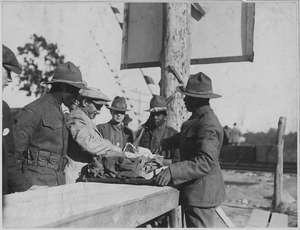Camp Upton
Camp Upton was a port of embarkation of the United States Army during World War I. During World War II it was used to incarcerate American citizens of Japanese descent.[1] It was located in Yaphank, New York in Suffolk County on Long Island, on the present-day location of Brookhaven National Laboratory.

History
World War I
Camp Upton, with a capacity of 18,000 troops was one of three transient embarkation camps directly under control of the New York Port of Embarkation during World War I.[2] The camp was named after Emory Upton, a Union general of the Civil War. The camp was created in 1917 to house troops as they awaited ships for deployment overseas.[2] From Camp Mills the units traveled by trains of the Long Island Rail Road to board ferryboats for the overseas piers in Brooklyn or Hoboken when scheduled for embarkation aboard troop ships.[2]
The 152nd Depot Brigade was the garrison unit that received new recruits and prepared them for service overseas, and then out processed demobilizing soldiers at the end of the war. Irving Berlin, the composer, and Alvin York, the most decorated soldier of the American army in World War I, were processed at Camp Upton. The 77th Division was first organized there. During part of the war, the 82nd Division was quartered there.
At the end of World War I, the camp was used to demobilize and inactivate units. Some of the units demobilized at the camp were: the 327th Infantry Regiment, the 325th Infantry Regiment, the 27th Infantry Division's 53rd Brigade (105th, 106th Infantry Regiments and the 105th Machine Gun Battalion), and the 101st Signal Battalion.
In May 1919, Camp Upton became the site of the Recruit Educational Center, an Army program that enrolled foreign-born, non-English speaking, and illiterate soldiers. Most of the Recruit Educational Center's inductees were immigrants from Eastern and Southern Europe. In practice, the program aimed to "Americanize" these immigrants through instruction in the English language, military protocol, U.S. history, geography, citizenship, and political economy. Soldiers who graduated from the Recruit Educational Center at Camp Upton were eligible for a three-year term of military service, after which they could be naturalized as American citizens.[3]
In 1921, the federal government sold the buildings and equipment, but kept the land, designating it Upton National Forest. Many of the structures from the camp were transported to form the first large scale settlement at Cherry Grove, New York on Fire Island.[4]
Internment of Americans of Japanese descent during World War II
It was used again by the Army in the mobilization of 1940 that preceded the American entry into World War II. As part of the nationwide internment of Japanese Americans approximately 1,000 Japanese Americans were kept there, under tight security, behind multiple layers of barbed wire fence.[5][6] Camp Upton was also used to hold Japanese citizens who were in New York City at the time war broke out, including businessmen with whom the governments of Japan and the United States negotiated an exchange.[7]
Camp Upton later housed a convalescent and rehabilitation hospital.
Brookhaven National Laboratory
In 1946, after the camp was closed, the federal government chose the site to build a nuclear research facility that would retain America's preeminence in that field. The former Camp Upton was renamed Brookhaven National Laboratory and was operated by AUI, a consortium of universities, for the United States Atomic Energy Commission.
In popular culture
Irving Berlin, while stationed at Camp Upton, wrote a musical, Yip, Yip, Yaphank, which included the memorable song "Oh! How I Hate to Get Up in the Morning." The musical was turned into a 1943 movie This Is The Army which starred Ronald Reagan.[8]
References
- "Japanese Internment Camps During World War 2". New York Daily News. New York: Daily News L.P. Retrieved February 20, 2017.
- Huston, James A. (1966). The Sinews of War: Army Logistics 1775—1953. Army Historical Series. Washington, DC: Center Of Military History, United States Army. pp. 346–347. LCCN 66060015. Retrieved 23 October 2014.
- Johnson, William Fletcher (January 1920). "Students at Camp Upton". North American Review: 44–50. Retrieved 30 August 2012.
- Cherry Grove: Before and After the Great Hurricane of 1938 – Fireisalndqnews.com – Retrieved November 1, 2007
- Kashima, Tetsuden (2003). Judgment without Trial. Japanese American Imprisonment during World War II . University of Washington Press . p. 256. ISBN 9780295984513.
- Summerfeldt, Chris (November 21, 2016). "Pro-Donald Trump spokesman praises Muslim registry, cites Japanese internment camps as 'precedent'". New York Daily News.
- Elleman, Bruce (2006). Japanese-American Civilian Prisoner Exchanges and Detention Camps, 1941-45. Routledge. p. 29. ISBN 9780415331883.
- Crichton, Kyle (Oct 17, 1942). "This is the Army". Collier's: 14–15. Retrieved 31 August 2012.